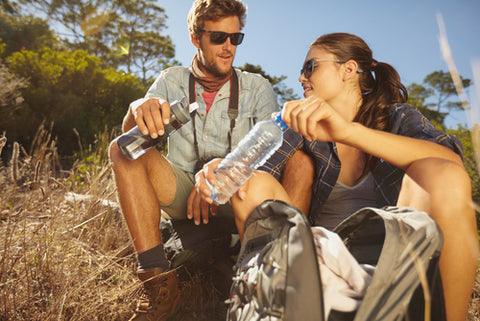State Parks in the US vary greatly in what type of services are offered in the park itself, so it’s important to bring your own supplies and everything you need for a successful day of hiking. Some state parks can be very remote with no food, no water, and no emergency services offered close by. Other state parks do offer drinking water, food vendors, restaurants, park employees, and emergency services. Research before you go and to see if they are open during the time of year you plan to visit.
Regardless of what the state park offers, it’s very important to bring your own basic necessities such as water, food, and a first aid kit. Below we have broken down the top 10 items to bring when hiking in a US state park, listed in importance from top to bottom.

Water
Staying hydrated is key to having a successful and safe hike in a state park. Factors such as state park elevation, fitness level, hike difficulty and length, and weather all impact how much water you need to drink to stay hydrated. Bring more than enough water as you may end up needing it all!

Food
Bring snacks for the hike to keep your energy levels up. The best snacks for hiking are power bars, dried fruit, trail mix, raisins, granola bars, beef jerky, and bananas. Some state parks have restaurants, food trucks, or snack machines, while others offer no food whatsoever.
First Aid Kit
Being prepared for anything means having a first aid kit. Even on a short ‘easy’ hike, anything can happen. A first aid kit is small and light enough to fit in your backpack and can be vital to helping you from small injuries to large injuries.
Hiking First Aid Kit items include: band aids, sterile pads, antibiotic ointment, antiseptic wipes, blister treatments, adhesive tape and bandages, insect sting treatment, safety pins, pain relieving medication, splints, prescription meds, aspirin, knife, tweezers, gloves, CPR mask, iodine tablets for water purification, and other specific medical items to yourself (diabetic specific meds, allergy specific meds, EpiPen for Bee sting allergies, etc.)
State Park and Area Maps
US state park trails can be very well maintained with proper signage, while other state parks can be poorly maintained with overgrown trails or lack of signage. Before you go on a hike, download some maps from online to your phone. US state parks offer free maps online and can be found with a simple search.
It’s also important to bring physical maps as your phone could die out on the trail. Some state parks do not have physical maps available to take, so bring your own before you go.

Proper Hiking Footwear
Having the right hiking shoes will make the hike much more enjoyable as well and will prevent injuries from falling due to improper footwear. Wear hiking specific shoes with a solid sole to handle the trail conditions. Most hiking trails are rocky with dirt, sand, or other natural footing. Research before you go what the trail conditions are during the time of year you plan on hiking. Summer trail conditions will be very different from winter conditions and may require different types of footwear. Waterproof shoes may be necessary on some hikes.
Proper Clothing
Having the right clothing will make the hike much more enjoyable! Do some research before you go to see what the weather forecast is in the area of the hike. Remember to prepare for any weather, even if the forecast says one thing. Layering your clothes is the best way to dress for any weather.

Toilet Paper and Plastic Bags
US state parks encourage all hikers to practice Leave No Trace. The principles of Leave No Trace include packing out anything you pack in and leaving only your footprints behind. Bring toilet paper and plastic bags to keep your trash in.
Sunscreen and Sunglasses
Be prepared for sunny weather, especially at high elevations. Research what the park elevation is before you go and pack accordingly. Higher elevation makes more powerful UV rays from the sun. Bring lots of sunscreen and sunglasses to protect your skin and eyes.

Warm Layers and Rain Gear
Prepare for any weather, including rain and snow. Bring lots of extra warm layers and a rain jacket. There is nothing worse than getting stuck in a rainstorm without a rain jacket and getting soaked to the bone, risking hypothermia even in warm temperatures.

Wildlife Viewing and Safety Gear
Research what type of wildlife is in the state park and pack accordingly. If wildlife is frequently seen in the park, bring binoculars and a camera to get an up-close look and some photos. If there is wildlife that is potentially dangerous such as bears, cougars, snakes, etc. research what the state park recommends bringing to protect yourself. US state parks with bears usually recommend having bear spray.
What you need to bring to the US state park for a hike will vary greatly depending on the time of year, weather, and your own personal fitness levels and hiking abilities. Being prepared for all types of weather, trail conditions, and emergency situations is essential to having a successful day hiking in the state park. Doing some research online before you go will help you know what you need to bring. Read recent reviews online from other hikers in the area to see what the trail conditions were like and how the weather was for them. Most of the time, reviews from other hikers will include things they wish they had brought! When you pack prepared, you won’t have a doubt in your mind and will have a great day hiking in the US state park!

